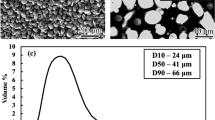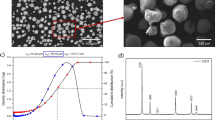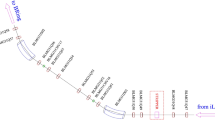Abstract
Deuteron-driven spallation targets have garnered attention recently because they can provide high-energy neutrons to transmute long-lifetime fission products. In this study, the Geant4 toolkit was used to simulate the interaction between a deuteron beam at 500 MeV and a composite target composed of alternating lead-bismuth eutectic (LBE) and water. The water was used because it may be employed as a target coolant. The energy spectrum, neutron yield, average energy, and total energy of the emitted neutrons were calculated for different thicknesses and thickness ratios between the LBE and water. For a constant target thickness, the neutron yield increases with an increasing thickness ratio of LBE to \(\hbox {H}_2\hbox {O}\), while the average energy of the emitted neutrons decreases with an increasing in the aforementioned thickness ratio . These two aspects support the use of a pure target, either LBE or water. However, with an increasing LBE-to-\(\hbox {H}_2\hbox {O}\) thickness ratio, the total energy of the emitted neutrons increases and then decreases. This result supports the addition of water into the LBE target. The angular distributions of the emitted neutrons show that the rear of the target is suitable for loading nuclear waste containing minor actinides and long-lifetime fission products.












Similar content being viewed by others
References
J.D. MacDonald, Safe and secure—environmental effects of nuclear power plants and the nuclear fuel cycle. IEEE Power Energy Mag. 4, 49–55 (2006). https://doi.org/10.1109/PAE-M.2006.247870
W.L. Zhan, H.S. Xu, Advanced fission energy program-ads transmutation system. Bull. Chin. Acad. Sci. 27, 375–381 (2012). https://doi.org/10.3969/j.issn.1000-3045.2012.03.017
B. Grambow, C. Landesman, S. Ribet, Nuclear waste disposal: I. Laboratory simulation of repository properties. Appl. Geochem. 49, 237–246 (2014). https://doi.org/10.1016/j.apgeochem.2014.05.017
H. Kunreuther, D. Easterling, W. Desvousges et al., Public attitudes toward siting a high-level nuclear waste repository in nevada. Risk Anal. 10, 469–484 (1990). https://doi.org/10.1111/j.1539-6924.1990.tb00533.x
C. McCombie, Nuclear waste management worldwide. Phys. Today 50, 56–62 (1997). https://doi.org/10.1063/1.881779
C. Fairhurst, Nuclear waste disposal and rock mechanics: contributions of the underground research laboratory (URL), pinawa, manitoba, canada. Int. J. Rock Mech. Min. Sci. 41, 1221–1227 (2004). https://doi.org/10.1016/j.ijrmms.2004.09.001
F. Venneri, M.A. Williamson, N. Li et al., Disposition of nuclear waste using subcritical accelerator-driven systems: technology choices and implementation scenarios. Nucl. Technol. 132, 15–29 (2000). https://doi.org/10.13182/nt00-a3126
Z.Q. Chen, Recent progress in nuclear data measurement for ADS at IMP. Nucl. Sci. Tech. 28, 184 (2017). https://doi.org/10.1007/s41365-017-0335-3
P. Yang, Z.K. Lin, W.S. Wan et al., Preliminary neutron study of a thorium-based molten salt energy amplifier. Nucl. Sci. Tech. 31, 41 (2020). https://doi.org/10.1007/s41365-020-0750-8
H. Abderrahim, P. Kupschus, E. Malambu et al., MYRRHA: a multipurpose accelerator driven system for research & development. Nucl. Instrum. Methods Phys. Res. Sect. A 463, 487–494 (2001). https://doi.org/10.1016/s0168-9002(01)00164-4
H. Nifenecker, S. David, J. Loiseaux et al., Basics of accelerator driven subcritical reactors. Nucl. Instrum. Methods Phys. Res. Sect. A 463, 428–467 (2001). https://doi.org/10.1016/S0168-9002(01)00160-7
K. Tsujimoto, T. Sasa, K. Nishihara et al., Neutronics design for lead-bismuth cooled accelerator-driven system for transmutation of minor actinide. J. Nucl. Sci. Technol. 41, 21–36 (2004). https://doi.org/10.1080/18811248.2004.9715454
H.Y. Meng, Y.W. Yang, Z.L. Zhao et al., Physical studies of minor actinide transmutation in the accelerator-driven subcritical system. Nucl. Sci. Tech. 30, 91 (2019). https://doi.org/10.1007/s41365-019-0623-1
C.D. Bowman, Accelerator-driven systems for nuclear waste transmutation. Annu. Rev. Nucl. Part. Sci. 48, 505–556 (1998). https://doi.org/10.1146/annurev.nucl.48.1.505
K. Tsujimoto, H. Oigawa, N. Ouchi et al., Research and development program on accelerator driven subcritical system in JAEA. J. Nucl. Sci. Technol. 44, 483–490 (2007). https://doi.org/10.1080/18811248.2007.9711312
D.E. Beller, Overview of the AFCI reactor-accelerator coupling experiments (race) project. Trans.-Am. Nucl. Soc. 90, 333–334 (2004)
D.D. Bruyn, H.A. Abderrahim, P. Baeten et al., The MYRRHA ADS project in Belgium enters the front end engineering phase. Phys. Proc. 66, 75–84 (2015). https://doi.org/10.1016/j.phpro.2015.05.012
T. Sasa, H. Oigawa, K. Tsujimoto et al., Research and development on accelerator-driven transmutation system at JAERI. Nucl. Eng. Des. 230, 209–222 (2004). https://doi.org/10.1016/j.nucengdes.2003.11.033
Z. Wang, Y. He, G. Huang, et al., in 10th International Particle Accelerator Conference, The status of ciads superconducting linac. JACOW Publishing, Geneva, Switzerland, 2019. https://doi.org/10.18429/JACoW-IPAC2019-MOPTS059
Z.L. Zhao, Y.W. Yang, H.Y. Meng et al., Preparation and verification of mixed high-energy neutron cross-section library for ADS. Nucl. Sci. Tech. 29, 140 (2018). https://doi.org/10.1007/s41365-018-0487-9
Z.Q. Liu, Z.L. Zhao, Y.W. Yang et al., Development and validation of depletion code system IMPC-burnup for ADS. Nucl. Sci. Tech. 30, 44 (2019). https://doi.org/10.1007/s41365-019-0560-z
A.A.A. Qaaod, V. Gulik, 226ra irradiation to produce 225ac and 213bi in an accelerator-driven system reactor. Nucl. Sci. Tech. 31, 44 (2020). https://doi.org/10.1007/s41365-020-00753-2
Z.L. Zhao, Y.W. Yang, S. Hong, Application of FLUKA and OpenMC in coupled physics calculation of target and subcritical reactor for ADS. Nucl. Sci. Tech. 30, 10 (2019). https://doi.org/10.1007/s41365-018-0539-1
G. Bauer, Overview on spallation target design concepts and related materials issues. J. Nucl. Mater. 398, 19–27 (2010). https://doi.org/10.1016/j.jnucmat.2009.10.005
F. Heidet, N.R. Brown, M.H. Tahar, Accelerator–reactor coupling for energy production in advanced nuclear fuel cycles. Rev. Accel. Sci. Technol. 08, 99–114 (2015). https://doi.org/10.1142/s1793626815300066
A. Class, D. Angeli, A. Batta et al., XT-ADS windowless spallation target thermohydraulic design & experimental setup. J. Nucl. Mater. 415, 378–384 (2011). https://doi.org/10.1016/j.jnucmat.2011.04.050
H.A. Abderrahim, P. D’Hondt, MYRRHA: A European experimental ADS for R & D applications status at mid-2005 and prospective towards implementation. J. Nucl. Sci. Technol. 44, 491–498 (2007). https://doi.org/10.1080/18811248.2007.9711313
K. Chen, Y. Yang, D. Fan et al., Thermal hydraulic studies of lead–bismuth eutectic spallation target of CIADS. Nucl. Eng. Des. 305, 672–677 (2016). https://doi.org/10.1016/j.nucengdes.2016.06.025
L. Yang, W. Zhan, New concept for ADS spallation target: gravity-driven dense granular flow target. Sci. China Technol. Sci. 58, 1705–1711 (2015). https://doi.org/10.1007/s11431-015-5894-0
Q. Zhao, W. Cui, Z. He et al., Energy deposition and neutron flux study in a gravity-driven dense granular target (DGT) with GEANT4 toolkit. Nucl. Instrum. Methods Phys. Res. Sect. B 427, 63–69 (2018). https://doi.org/10.1016/j.nimb.2018.04.045
Q. Zhao, X.Y. Zhang, W.J. Cui et al., Numerical study on the inner temperature measurement for the target in CiADS. Nucl. Instrum. Methods Phys. Res. Sect. B 432, 37–41 (2018). https://doi.org/10.1016/j.nimb.2018.07.017
Y.L. Zhang, X.C. Zhang, J. Qi et al., Study on the parameters of the ADS spallation target. J. Phys. Conf. Ser. 420, 012064 (2013). https://doi.org/10.1088/1742-6596/420/1/012064
A. Krasa, V. Wagner, M. Majerle et al., Neutron production in a pb/u-setup irradiated with 0.7–2.5 gev protons and deuterons. Nucl. Instrum. Methods Phys. Res. Sect. A. Detect. Assoc. Equip. 615, 70–77 (2010). https://doi.org/10.1016/j.nima.2010.01.029
J. Adam, V. Chilap, V. Furman et al., Study of secondary neutron interactions with 232th, 129i, and 127i nuclei with the uranium assembly “quinta”at 2, 4, and 8 gev deuteron beams of the jinr nuclotron accelerator. Appl. Radiat. Isot. 107, 225–233 (2016). https://doi.org/10.1016/j.apradiso.2015.11.002
Y. Malyshkin, I. Pshenichnov, I. Mishustin et al., Neutron production and energy deposition in fissile spallation targets studied with geant4 toolkit. Nucl. Instrum. Methods Phys. Res. Sect. B 289, 79–90 (2012). https://doi.org/10.1016/j.nimb.2012.07.023
A. Lamrabet, A. Maghnouj, J. Tajmouati et al., Assessment of the power deposition on the megapie spallation target using the geant4 toolkit. Nucl. Sci. Tech. 30, 54 (2019). https://doi.org/10.1007/s41365-019-0590-6
S. Lee, C. Bungau, R. Cywinski, in 7th International Particle Accelerator Conference IPAC2016, Geant4 simulations of proton-induced spallation for applications in ADSR systems (2016) https://doi.org/10.1007/s41365-019-0590-6
A. Koning, D. Rochman, Modern nuclear data evaluation with the talys code system. Nucl. Data Sheets 113, 2841–2934 (2012). https://doi.org/10.1016/j.nds.2012.11.002
M. Chadwick, M. Herman, P. Obložinský et al., Endf/b-vii.1 nuclear data for science and technology: cross sections, covariances, fission product yields and decay data. Nucl. Data Sheets 112, 2887–2996 (2011). https://doi.org/10.1016/j.nds.2011.11.002
Author information
Authors and Affiliations
Contributions
All authors contributed to the study conception and design. Material preparation, data collection, and analysis were performed by Wei-Wei Qiu, Wu Sun, and Jun Su. The first draft of the manuscript was written by Wei-Wei Qiu, and all authors commented on previous versions of the manuscript. All authors read and approved the final manuscript.
Corresponding author
Additional information
This work was supported by the National Natural Science Foundation of China (No. 11875328).
Rights and permissions
About this article
Cite this article
Qiu, WW., Sun, W. & Su, J. Neutronic analysis of deuteron-driven spallation target. NUCL SCI TECH 32, 94 (2021). https://doi.org/10.1007/s41365-021-00932-9
Received:
Revised:
Accepted:
Published:
DOI: https://doi.org/10.1007/s41365-021-00932-9




